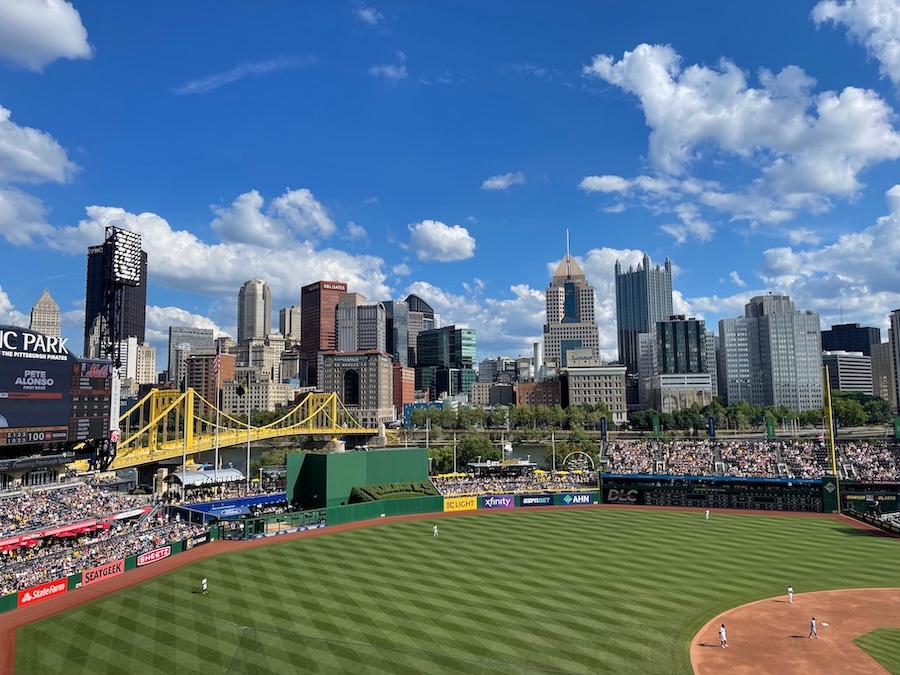Baseball enthusiasts and history buffs alike find a treasure trove of stories when diving into the storied past of the Pittsburgh Pirates. This iconic team, rich in legacy and cultural influence, has roots that stretch deep into the annals of American baseball history. From the early influence of the Homestead Grays and the Pittsburgh Crawfords to numerous triumphs and tribulations, the Pirates’ journey is a fascinating narrative that spans more than a century.
The formation of Pittsburgh’s first professional baseball team marked a significant era, bringing together a community of fans and forging a strong brand identity in the world of sports. Over the decades, the Pirates have seen transformative changes through ownership transitions, impactful name changes, and defining moments that both challenged and defined their path. These elements have not only shaped the team’s history but also left a lasting imprint on baseball culture and the broader sports landscape.
As we embark on the journey of unveiling the past, this article delves into the origins, evolution, and enduring legacy of the Pittsburgh Pirates. It highlights the achievements and setbacks, celebrates the legends who wore the Pirates jersey, and reflects on their cultural significance in both Pittsburgh and the broader baseball community. Whether you’re a die-hard fan or a curious newcomer, this exploration offers a compelling glimpse into what makes the Pirates’ history so profound and enduring.
Early Baseball in Pittsburgh
Baseball has a rich history in Pittsburgh, dating back to the late 19th century. Known for its passionate fans and vibrant baseball culture, the city was home to some of the earliest organized baseball teams in the country. The Pittsburgh Pirates, established in 1887 as part of the National League, trace their origins to this period. However, prior to their formation, several other teams contributed to the development of baseball in the region. Notably, the American Association team, Allegheny City, played at Recreation Park and later moved to Exposition Park. This era laid the groundwork for Pittsburgh’s deep-rooted connection to baseball, as it transitioned from smaller venues to the more prominent Forbes Field and eventually PNC Park in modern times.
The Role of the Homestead Grays
Amid the burgeoning baseball scene, the Homestead Grays emerged as a key player in Pittsburgh’s baseball history. Established in 1910, the team became one of the most successful and storied clubs in the Negro Leagues. Based initially in Homestead, a borough just outside Pittsburgh, the Grays attracted top African American talent, showcasing exceptional players who would later earn Hall of Fame status. Their games drew fans from all walks of life, bringing communities together around the sport they loved.
Led by legends like Josh Gibson and Buck Leonard, the Grays dominated their league, securing consecutive championships in various seasons. They played many of their home games at Forbes Field, which also hosted Major League Baseball’s Pittsburgh Pirates. This provided a unique opportunity for fans to witness the high-caliber performance of these players firsthand. The Grays contributed significantly to the rich tapestry of Pittsburgh’s baseball heritage, demonstrating that talent and passion knew no racial boundaries.
Influence of the Pittsburgh Crawfords
Alongside the Homestead Grays, the Pittsburgh Crawfords played a pivotal role in shaping the baseball landscape of Pittsburgh. Founded in the early 1930s, the Crawfords quickly became a powerhouse in the Negro Leagues. The team was remarkable for its roster, which featured some of the greatest players in history, including Satchel Paige and Cool Papa Bell. Their skillful play and strategic acumen earned them widespread respect and admiration across the leagues.
The Crawfords were known for playing their home games at Greenlee Field, one of the first black-owned stadiums in the United States. This venue symbolized a significant social and cultural milestone, empowering African American communities and providing a platform for black athletes to showcase their talents on an equal footing. Under the leadership of Gus Greenlee, the team’s owner and a noted businessman, the Crawfords saw substantial success throughout their active years, even challenging Major League teams with their remarkable talent. Their contributions to Pittsburgh’s baseball legacy cannot be overstated, as they helped to break down racial barriers and redefine opportunities for future generations in the sport.
Formation of the First Professional Team
The history of the Pittsburgh Pirates as a professional baseball team began in the late 19th century, during a pivotal period that marked the evolution of baseball into a more structured and competitive sport. The foundation of the team was rooted in the burgeoning popularity of baseball as it transitioned from a recreational pastime to an organized professional endeavor. This shift paved the way for the emergence of new teams and leagues across the country.
Origins and Early Development
The origins of what would become the Pittsburgh Pirates can be traced back to 1881 in Allegheny City, a region now part of modern-day Pittsburgh. Initially, the team was formed as part of the American Association under the name Allegheny, but it soon moved to the National League in 1887. This transition marked the beginning of the Pirates’ establishment in Major League Baseball. The early years were marked by the contributions of influential figures like Denny McKnight, who played a crucial role in organizing the team.
By the time the team joined the National League, they played their home games at Recreation Park, one of the early ballparks in baseball history. During its formative years, the team faced numerous challenges and intense competition from other teams, particularly those in the National League. Despite these challenges, the team’s persistence laid a solid foundation for future success and growth into one of the most storied franchises in Major League Baseball.
Initial Name and Brand Identity
The Pittsburgh team initially went by the name “Allegheny” when they played in the American Association. However, a pivotal moment in their branding history came in 1891 when they acquired second baseman Louis Bierbauer. This acquisition was controversial as it was seen as piratical, resulting in the team’s unofficial but enduring nickname, the “Pirates.” This incident significantly impacted the team’s identity, shaping its brand in the eyes of fans and rivals alike.
Throughout the early years, the Pirates embraced their new moniker, fostering a unique brand identity centered around tenacity and rebellious spirit. The team’s narrative was further enriched by their gameplay, earning them recognition as formidable competitors in Major League Baseball. This strong branding endured through the years, allowing the Pirates to cultivate a robust fan base and an iconic identity that continues to resonate in the hearts of Pittsburgh fans and the baseball community.
Evolution of the Franchise
The history of the Pittsburgh Pirates is a storied tale of transformation, resilience, and success in Major League Baseball. Established as one of baseball’s most enduring teams, their journey from humble beginnings to becoming a dominant force in the league involves numerous phases, each significant in its own right. As members of the National League, the Pirates have left an indelible mark on professional baseball, creating a legacy that has been enriched by legendary players, strategic owners, and unforgettable moments. This section explores the pivotal changes that have shaped the Pirates throughout their extensive timeline and delves into the noteworthy instances of rebranding and leadership shifts that have propelled the team to its current status.
Significant Name Changes
The Pittsburgh Pirates’ identity has evolved notably since their inception, reflecting important changes in the team’s ownership, location, and philosophy. Originally founded in 1882 as the Allegheny team in Allegheny City, the team was part of the American Association. Shortly after, they joined the National League in 1887 and underwent their first rebranding when they were informally known as the Pittsburgh Alleghenys, playing at venues like Recreation Park and Exposition Park.
The major turning point came in the early 1890s after a controversial acquisition of second baseman Louis Bierbauer from the defunct Philadelphia Athletics. This acquisition led to allegations of “pirating” the player, a charge that was embraced by the team, resulting in their official renaming to the “Pirates” by 1891. This marked a definitive shift in the team’s identity, symbolizing an unapologetic competitiveness that has characterized their ethos ever since.
This iconic name change established the Pirates’ brand, with future adjustments being minor in comparison. Throughout the 20th century, the Pirates became synonymous with Pittsburgh, with the team setting roots in landmark venues like Forbes Field and later PNC Park. These home fields have seen the Pirates’ identity reinforced, fostering both a regional pride and a global recognition as a consistent contender in major leagues.
Ownership Transitions and Impact
The ownership of the Pittsburgh Pirates has been as varied and dynamic as the team’s on-field fortunes, playing a critical role in shaping the team’s history. Initial operations in the 19th century were managed by a consortium of business interests, with Denny McKnight being pivotal in steering the early course as one of the inaugural figures in leadership.
In 1900, the dynamic leadership of Barney Dreyfuss marked a significant era as he took the helm, steering the team to an unprecedented period of success. Under Dreyfuss, notable achievements included multiple National League titles and a World Series victory in 1909, cementing players like Honus Wagner in the Hall of Fame and solidifying the team’s reputation.
Following Dreyfuss’ death in the 1930s, the years witnessed various ownership changes, each leaving unique imprints on the organization’s structure and ambitions. Perhaps most notably, the leadership of Galbreath and Crosby families in the mid-20th century saw the Pirates clinch dramatic World Series titles in 1960 and 1971, both under the management of revered figure Danny Murtaugh.
The modern era commenced in 1996, under the stewardship of Kevin McClatchy and later the locally cherished Nutting family. This period has been marked by the transition to PNC Park and the challenge of restoring former glories amidst competitive pressures. Each ownership phase has impacted the Pirates’ strategies, from player acquisitions to community engagement, demonstrating how foundational ownership is to the narrative of a successful baseball team.
Defining Moments in Pirates History
The Pittsburgh Pirates are one of Major League Baseball’s oldest and most storied franchises. Established in 1882 as part of the American Association before joining the National League in 1887, the team’s rich history is marked by both significant achievements and challenging periods. Originating in Allegheny City, the Pirates quickly established themselves as a formidable professional baseball team. Over the years, the Pirates have experienced various highs and lows, including exhilarating championship victories and heartbreaking defeats. Their journey reflects a blend of great triumph and endurance in the face of adversity. This chronicle of defining moments captures the essence of the Pirates’ historic legacy—from nail-biting walk-off home runs to pivotal games that have etched their name in the annals of baseball history.
Notable Achievements and Championships
The Pittsburgh Pirates boast numerous achievements that underscore their historical impact on major leagues. One of their most celebrated accomplishments is winning five World Series championships, with the victories in 1909, 1925, 1960, 1971, and 1979 standing out. The 1960 series was particularly remarkable, featuring Bill Mazeroski’s legendary ninth-inning walk-off home run in Game 7 against the New York Yankees. This moment remains one of baseball’s most memorable highlights. The Pirates are also known for their early dominance in the National League, spurred by iconic players like Honus Wagner, who secured eight batting titles, establishing himself as one of the greatest in the game. Under the stewardship of manager Fred Clarke, the team clinched multiple National League pennants, cementing their status as a perennial powerhouse. The Pirates’ commitment to excellence continued with noteworthy players like Barry Bonds, who further enhanced their legacy with his impressive performances and National League MVP awards.
Times of Adversity and Setbacks
The Pirates also faced periods of challenges, marked by consecutive losing seasons that tested their resilience and ability to rebuild. Particularly in the late 20th and early 21st centuries, the team struggled with extended slumps, notably enduring a streak of 20 consecutive losing seasons from 1993 to 2012. Despite these setbacks, the Pirates managed to regroup and remain competitive within the National League narrative. The team’s determination to overcome adversity has been a testament to their enduring spirit. Leadership under figures like Danny Murtaugh, who steered the team through tough periods as manager, and the collective effort of players and fans alike have played an integral role in propelling the Pirates back to prominence. These challenging eras provided valuable lessons, reinforcing the franchise’s resilience and commitment to turning fortunes around.
Tragic Events that Shaped the Team
The history of the Pittsburgh Pirates is also dotted with tragic events that profoundly impacted the team and its community. One such event was the plane crash in 1972 that claimed the life of Roberto Clemente, a legendary Hall of Fame player known for his exceptional talent and humanitarian efforts. Clemente’s untimely death while delivering aid to earthquake victims in Nicaragua cast a long shadow over the team and left an indelible mark on the sport. His legacy, however, continues to inspire future generations of players. The Pirates mourned their loss but rallied to honor his memory, underscoring the profound influence Clemente had both on and off the field. Other difficult times came with the demolishing of Forbes Field and subsequent moves to new venues like PNC Park, which represented both a fresh start and the end of an era. These events have shaped the Pirates’ journeys, reflecting the broader narrative of perseverance and remembrance throughout their storied history.
The Pirates’ Notorious Name
The Pittsburgh Pirates, one of Major League Baseball’s storied franchises, have a fascinating history behind their notorious moniker. This iconic name captures the adventurous spirit of the team and is intricately linked to a pivotal moment in the early years of professional baseball. Over the decades, the Pirates have become synonymous with resilience and daring gameplay, but their name was born out of controversy and bold decision-making. The story of how the Pirates got their name offers insight into their enduring reputation and the challenges they’ve faced since their inception in the late 19th century.
How the Name Was Earned
The Pirates’ name originates from a bold maneuver in the 1890s regarding player contracts, a contentious issue at the time in professional baseball. In 1891, the team, then known as the Pittsburgh Alleghenys, was involved in a contract dispute over Louis (Lou) Bierbauer. Bierbauer, a talented infielder, was left off the reserved list of the Philadelphia Athletics after the American Association disbanded. The Alleghenys stealthily signed him, capitalizing on this oversight, a move perceived by many as underhanded or piratical in nature. Amidst outcry and accusations from rival teams, a newspaper headline declared the Pittsburgh team as “pirates,” a term that struck a chord with the fans and media alike.
This distinctive nickname rapidly gained popularity, overshadowing the Alleghenys’ original team name. The National League, recognizing the public’s adoption of the term, officially acknowledged the Pirates as the franchise’s new name by 1891. Thus, through a somewhat audacious player acquisition, the Pittsburgh Pirates were born, marking their place in baseball history with a name that implies cunning, strategy, and a willingness to push boundaries.
Influence on Team Perception
The Pirates’ name has significantly influenced how the team is perceived both in and out of the sporting world. The name conjures images of adventure, daring, and a never-say-die attitude, qualities that the team has embodied throughout its history. The Pirates have often played the underdog role, an identity that resonates with the notion of pirates as outsiders who challenge the status quo.
Historically, this perception has sometimes worked to the Pirates’ advantage, galvanizing fans and players around a shared narrative of defying odds and expectations. As they navigate the challenges of Major League Baseball, the Pirates’ moniker serves as a reminder of their origins from a bold act, aligning them with the swashbucklers of old who seized opportunities and carved their fate.
Despite periods of struggle, including several consecutive losing seasons, the team has maintained a loyal fan base that cherishes their unique identity. This enduring support is a testament to the power of a captivating name and its ability to inspire and unify. The story of the Pittsburgh Pirates underscores how a name, born of controversy, can evolve into a proud emblem of a team’s spirit and its journey through the annals of baseball.
Contributions to Baseball Culture
The Pittsburgh Pirates, an essential part of Major League Baseball’s rich history, have left an indelible mark on the cultural landscape of the sport. With their roots tracing back to the late 19th century, the Pirates have not only been influential in shaping baseball’s traditions but also in fostering a deep sense of community among fans and players alike. Known for their passionate fan base and iconic ballparks such as Forbes Field and PNC Park, the Pirates have played a significant role in promoting and developing baseball in America. Their journey from humble beginnings at Exposition Park and Recreation Park to their current standing reflects both their challenges and triumphs over the decades.
Innovations and Milestones
The history of the Pittsburgh Pirates is laden with groundbreaking elements and achievements that have contributed to their storied legacy in baseball. They were trailblazers in building a cohesive team, reflecting the city’s evolving industrial spirit by forging an identity that embraced both grit and innovation. Hosting some of baseball’s most memorable moments, the Pirates have provided fans with numerous thrilling games, including dramatic ninth inning finishes and iconic walk-off home runs.
Throughout their history, the Pirates have been part of several pivotal changes in baseball. They were among the first teams to popularize the use of modern baseball parks, transitioning from Union Park to the integral ballpark era of Forbes Field. The Pirates also embraced technological advancements and analytics early on, enabling them to adapt strategies that have kept them competitive in the major leagues. With each stride towards innovation, the Pirates solidified their reputation as a team that not only adapted to change but leveraged it to carve out their unique niche in baseball’s cultural tapestry.
Prominent Players and Legends
Central to the Pirates’ impact on baseball culture is their roster of legendary players who have shaped the team’s—and indeed, baseball’s—history. Honus Wagner, perhaps one of the most iconic figures to have donned a Pirates uniform, is regarded as one of the greatest shortstops in the history of the game. His prowess earned him multiple batting titles and a revered place in the Hall of Fame. His era set the tone for Pittsburgh’s commitment to excellence on the field.
The team has also been home to other remarkable players like Barry Bonds, whose dynamic performances during the late 1980s and early 1990s electrified fans and showcased incredible talent. Fred Clarke, another pivotal figure in the Pirates’ history, not only contributed as a player but also as a manager, guiding the team to significant victories. Danny Murtaugh’s managerial skills further pushed the Pirates towards glory, culminating in division titles that etched the team into the annals of Major League Baseball success stories.
The Pirates have consistently fostered talent that defines baseball’s evolving narrative. Each star associated with the team has contributed to a legacy of resilience and excellence, resonating with fans across generations and establishing Pittsburgh as a formidable force in the National League.
The Pirates’ Modern Era
The Pittsburgh Pirates, a historic professional baseball team rooted in Major League Baseball’s rich tapestry, have encountered a myriad of shifts in the modern era. This period is distinguished by both challenges and periods of revitalization. As the Pirates moved forward from the latter half of the 20th century, they faced the evolving dynamics of the sport and financial pressures characteristic of modern baseball. This has been a time of fluctuating competitive stature, where the team aspired to recapture past successes while navigating the complexities of the major leagues.
Recent Struggles and Successes
Over the past few decades, the Pittsburgh Pirates have experienced their share of ups and downs. The team struggled for consistent success during several seasons, reflecting a difficult stretch in their franchise history marked by consecutive losing seasons. However, these challenges did not overshadow the times when the Pirates demonstrated resurgence on the field. Noteworthy successes in the modern era include making playoff appearances in the early 2010s, which provided a semblance of hope and excitement for their loyal fan base.
In particular, the Pirates’ success during these playoff runs was emblematic of a team showing flashes of its historical glory. Clinching a spot in the postseason conveyed progress and renewed optimism. Although these peaks were not sustained, they served as a reminder of the franchise’s potential. This balance of struggle and triumph is integral to understanding their recent team dynamics and efforts to rebuild and compete at a high level consistently.
Current Standing in Major League Baseball
At present, the Pittsburgh Pirates find themselves striving to elevate their stature within Major League Baseball. The team plays their home games at PNC Park, one of the most picturesque venues in the league. Despite the challenges, the Pirates continually work to develop young talent and build a cohesive unit oriented toward future success. The focus on fostering skills and acquiring promising players aims to strengthen the roster and enhance their competitive edge.
Navigating the National League Central, the Pirates face formidable opponents, which requires strategic management of resources and player development. As they aim to improve their standings, the team’s efforts are underscored by a commitment to blending veteran leadership with youthful potential. Engaging both fans and players in this growth journey is paramount, with hopes to transform their current standing into a stepping stone for a more prosperous future in baseball. This ongoing journey reflects the Pirates’ enduring spirit and the continuous endeavor to carve out a notable place in contemporary baseball history.
Reflecting on the Pirates’ Legacy
The Pittsburgh Pirates, one of Major League Baseball’s oldest and most storied franchises, boast a rich history that spans over a century. As a founding member of the National League, the team has played a crucial role in shaping professional baseball. From their humble beginnings in Allegheny City to their current home at PNC Park, the Pirates have created a legacy filled with legendary players and memorable moments. Their journey includes triumphs in several World Series, contributions from Hall of Famers like Honus Wagner and Roberto Clemente, and unforgettable games that have left an indelible mark on the sport.
Cultural and Sports Impact in Pittsburgh
The Pirates have been an integral part of Pittsburgh’s cultural and sports landscape. From the early days at Exposition Park and Recreation Park, where fans first gathered to support their local team, the Pirates have secured a place in the hearts of the city’s residents. Forbes Field, where the team scored consecutive seasons of success in the early 20th century, became a symbol of Pittsburgh pride. As the Pirates evolved, so did their connection to the community, nurturing a passionate fan base that has followed them through both glorious victories and challenging seasons. The arrival of celebrated players such as Paul Skenes and Bryan Reynolds brought new life to the team and inspired hope for future success.
Resources for Further Exploration
For those interested in exploring the history of the Pittsburgh Pirates further, numerous resources delve deep into their extensive past. Historians and baseball enthusiasts have documented the team’s early years, providing detailed accounts of their development from the American Association to a dominant force in the National League. Books, documentaries, and online archives offer insight into key figures like Fred Clarke and Danny Murtaugh, who left lasting legacies within the franchise. Additionally, the team’s website and local Pittsburgh libraries house invaluable collections of photographs, interviews, and articles chronicling the Pirates’ contribution to major leagues and their memorable walk-off home runs and division titles.







